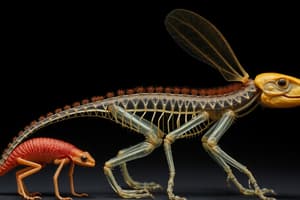Podcast
Questions and Answers
What is the common ancestor of protists classified as?
What is the common ancestor of protists classified as?
- Eukaryotes (correct)
- Bacteria
- Cyanobacteria
- Archaea
Which group does the taxon Sarcopterygii belong to?
Which group does the taxon Sarcopterygii belong to?
- Echinoderms
- Deuterostomes (correct)
- Protostomes
- Cnidarians
Which of the following is NOT considered a part of Vertebrates?
Which of the following is NOT considered a part of Vertebrates?
- Actinopterygii
- Amniota
- Tetrapoda
- Echinoderms (correct)
Which class includes organisms such as Homo sapiens and Chimpanzees?
Which class includes organisms such as Homo sapiens and Chimpanzees?
What clade includes both Crocodylia and Aves?
What clade includes both Crocodylia and Aves?
Which group is classified as a protist within the Tree of Life?
Which group is classified as a protist within the Tree of Life?
Which of the following is a characteristic of the group Angiosperms?
Which of the following is a characteristic of the group Angiosperms?
Which group includes the organisms known as Lamprey and Hagfish?
Which group includes the organisms known as Lamprey and Hagfish?
Which of these statements accurately describes the relationship between green plants and green algae?
Which of these statements accurately describes the relationship between green plants and green algae?
In the classification of vertebrates, which group is directly related to Amniota?
In the classification of vertebrates, which group is directly related to Amniota?
Which of the following groups does NOT fall under the category of bilaterians?
Which of the following groups does NOT fall under the category of bilaterians?
Which of the following is a category within the protists as depicted in the Tree of Life?
Which of the following is a category within the protists as depicted in the Tree of Life?
Which statement best describes the relationship between vertebrates and deuterostomes?
Which statement best describes the relationship between vertebrates and deuterostomes?
Which of the following classes is incorrectly paired with its group within the vertebrates?
Which of the following classes is incorrectly paired with its group within the vertebrates?
Which clade does the group 'Great Apes' belong to?
Which clade does the group 'Great Apes' belong to?
What is the primary characteristic that distinguishes Archaeal organisms in the Tree of Life?
What is the primary characteristic that distinguishes Archaeal organisms in the Tree of Life?
Which of the following is considered a member of the 'Opisthokonts' group?
Which of the following is considered a member of the 'Opisthokonts' group?
Flashcards are hidden until you start studying
Study Notes
Protists and Eukarya
- Protists are classified under the domain Eukarya, which signifies complex cellular structure.
- The common ancestor of all protists can be traced back to early eukaryotes.
Tree of Life Overview
- The tree of life segments into various clades, illustrating evolutionary relationships.
- Vertebrates are part of the broader category of Deuterostomes, characterized by their embryonic development.
- Within animals, Opisthokonts include groups such as fungi and certain protists.
Vertebrate Evolution
- Sarcopterygii are lobe-finned fishes leading to the evolution of Tetrapoda, which includes four-limbed animals.
- Amniota refers to a group capable of laying eggs on land, further divided into:
- Reptilia: Includes birds (Aves), crocodilians (Crocodylia), turtles (Testudines), and lizards/snakes.
- Great Apes: Encompasses modern humans (Homo sapiens), chimpanzees, and the duck-billed platypus.
- Mammalia branches from Tetrapoda, leading to various classes including amphibians and lungfish.
Diverse Groupings
- Protostomes include diverse organisms like echinoderms, octopuses, and sponges.
- Fungi and various Protists are incorporated into the broader animal tree.
Plants and Algae
- Angiosperms (flowering plants) and Gymnosperms (naked-seed plants) evolved from earlier plant lineages.
- Green plants date back to green algae, divided into Stoneworts and Chlorophytes.
- Other algal groups include red algae and several protist categories, including Rhizaria and Discoba.
Bacteria and Archaea
- Archaea are subdivided into categories like Asgard and DPANN, highlighting their genetic diversity.
- Proteobacteria, a major phylum in bacteria, includes cyanobacteria, the oxygen-producing bacteria crucial for life on Earth.
Key Taxonomic Relationships
- Knowledge of taxonomic relationships helps understand the evolutionary history and classifications of various life forms.
- The tree illustrates layers of evolutionary development, emphasizing the complexity and interconnections of terrestrial and marine life.
Protists and Eukarya
- Protists are classified under the domain Eukarya, which signifies complex cellular structure.
- The common ancestor of all protists can be traced back to early eukaryotes.
Tree of Life Overview
- The tree of life segments into various clades, illustrating evolutionary relationships.
- Vertebrates are part of the broader category of Deuterostomes, characterized by their embryonic development.
- Within animals, Opisthokonts include groups such as fungi and certain protists.
Vertebrate Evolution
- Sarcopterygii are lobe-finned fishes leading to the evolution of Tetrapoda, which includes four-limbed animals.
- Amniota refers to a group capable of laying eggs on land, further divided into:
- Reptilia: Includes birds (Aves), crocodilians (Crocodylia), turtles (Testudines), and lizards/snakes.
- Great Apes: Encompasses modern humans (Homo sapiens), chimpanzees, and the duck-billed platypus.
- Mammalia branches from Tetrapoda, leading to various classes including amphibians and lungfish.
Diverse Groupings
- Protostomes include diverse organisms like echinoderms, octopuses, and sponges.
- Fungi and various Protists are incorporated into the broader animal tree.
Plants and Algae
- Angiosperms (flowering plants) and Gymnosperms (naked-seed plants) evolved from earlier plant lineages.
- Green plants date back to green algae, divided into Stoneworts and Chlorophytes.
- Other algal groups include red algae and several protist categories, including Rhizaria and Discoba.
Bacteria and Archaea
- Archaea are subdivided into categories like Asgard and DPANN, highlighting their genetic diversity.
- Proteobacteria, a major phylum in bacteria, includes cyanobacteria, the oxygen-producing bacteria crucial for life on Earth.
Key Taxonomic Relationships
- Knowledge of taxonomic relationships helps understand the evolutionary history and classifications of various life forms.
- The tree illustrates layers of evolutionary development, emphasizing the complexity and interconnections of terrestrial and marine life.
Studying That Suits You
Use AI to generate personalized quizzes and flashcards to suit your learning preferences.




